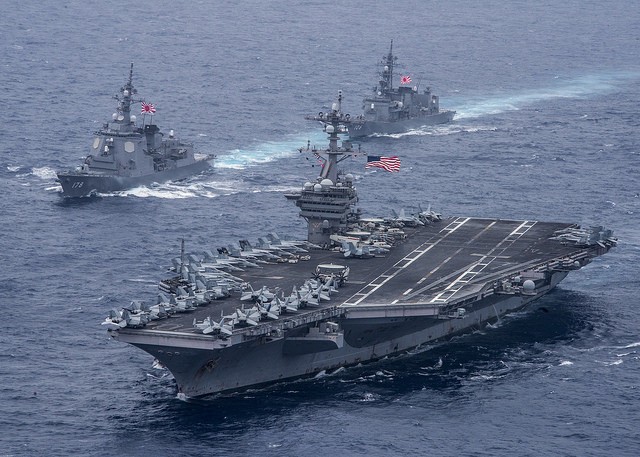Japanese fighter jets conduct joint drill with U.S. carrier off Okinawa
Japanese fighter jets conduct joint drill with U.S. carrier off Okinawathe USS Carl Vinson carrier strike group for joint drills Friday in waters east of Okinawa as the U.S. vessel steamed toward the Sea of Japan amid soaring tensions on the Korean Peninsula.
The exercise had earlier been scheduled for Wednesday, but bad weather forced its cancelation.

The USS Carl Vinson aircraft carrier, the Maritime Self-Defense Force destroyers Ashigara (left) and Samidare (back) transit the Philippine Sea on Wednesday. | U.S. NAVY
Two ASDF F-15s based in Naha, Okinawa Prefecture, and two U.S. Navy F/A-18 aircraft dispatched with the Vinson took part in the drill, the ASDF said in a statement. Two Maritime Self-Defense Force destroyers, the Samidare and the Ashigara, as well as the Vinson and several other U.S. Navy ships were also participating in the drill.
Although the ASDF often holds joint exercises with the U.S. Air Force, one involving an aircraft carrier is a rarity.
The drill “further strengthens the deterrence power of the Japan-U.S. alliance, shows our country’s commitment to the region’s stability and demonstrates its advanced capabilities,” Defense Minister Tomomi Inada told a news conference.
In an earlier statement, the U.S. Navy’s 7th Fleet said the exercise would be focused on “combined air training and information sharing to increase interoperability and communication among joint services.”
The ramped-up activity comes as Pyongyang seeks to master not only the technology to mount nuclear warheads on long-range missiles, but also the improved ability to hit Japan with its more reliable shorter-range weapons.
In one particularly worrisome development, the North conducted a near-simultaneous launch of four extended-range Scud missiles in March as a rehearsal for striking U.S. military bases in Japan.
The latest joint drills were held after a highly publicized two-day bilateral maritime exercise with the Vinson-led carrier group and MSDF ships as they transited the Philippine Sea on Sunday and Monday.
“Both exercises demonstrate the flexibility of U.S. naval forces and Japan Self-Defense forces to work together in a maritime environment in order to quickly respond to threats in the region,” the 7th Fleet said.
On Tuesday, the two allies also held a joint missile-defense drill in the Sea of Japan that involved Aegis-equipped ships from both navies.
Malcolm Davis, a senior defense analyst at the Australian Strategic Policy Institute, said the joint exercises conveyed the two allies’ united stance on North Korean aggression.
They are “sending a message of deterrence to Pyongyang — that Japan will not be passive in the face of a clear and direct threat to Japanese security from North Korea,” Davis said.
The joint drills could also be seen as a push to compel Beijing to heap more pressure on Pyongyang and North Korean leader Kim Jong Un over his nuclear and missile programs.
“I think the signal for the North is that Japan is willing to support the U.S. and create the circumstances that will pressure China to apply more pressure on the Kim regime,” said Stephen Nagy, a senior associate professor of politics at International Christian University in Tokyo.
“Supporting THAAD (Terminal High Altitude Area Defense) installment in South Korea and sending ships into the Sea of Japan and Yellow Sea, and expanded partnerships erodes China’s security environment to a point that they may throw Mr. Kim under the bus or they may apply enough pressure to tone down the provocations on the peninsula,” Nagy said, referring to the contentious THAAD anti-missile defense system.
BY JESSE JOHNSON
STAFF WRITER
Source:japantimes.co.jp